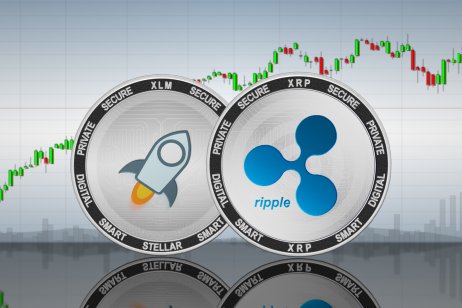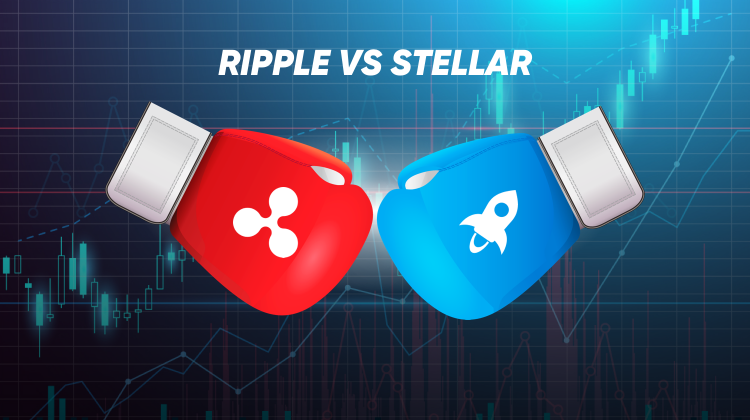Stellar vs Ripple: which one is a better pick in 2021?
By John Shepard
15:00, 27 January 2021

Stellar and Ripple are two altcoins that have been on the cryptocurrency scene for over six years. Both coins saw strong rallies in the late-2017 boom that saw Bitcoin hitting the $20,000 level. However this year has already seen BTC trading above $40,000, yet gains in the altcoins have been harder to come by.
Use cases
When deciding on whether to choose Ripple or Stellar, we have to consider their potential for gaining the most users. Ripple’s XRP coin was a favourite investment for many who fantasised about altcoin riches, and the coin had a very passionate community supporting it. XRP was designed as a cross-border currency with low transaction fees and fast execution. For this reason, many saw it as an alternative to the traditional financial system, where international money transfers were costly and could take days, where XRP transactions could be settled in less than five seconds.
Stellar’s project is similar to Ripple’s but has expanded into a wider range of products. The project offers global payment apps that leverage the currency-backed tokens that already exist on the Stellar network. Alongside this, there is a built-in decentralised exchange, which allows users to swap crypto, forex, or other securities. Finally, Stellar has built a micropayments service, which could be used for tipping or subscriptions.
Supply
Stellar lumens are not mined and 100 billion XLM coins were minted when the Stellar network went live. The supply was set to grow one per cent per year but the inflationary approach was later removed after a community vote. Following that, the XLM supply was reduced by half. This sent the price of the coin higher and there are currently 22 billion coins circulating from a supply of 50 billion.
The circulating supply of XRP is currently 45 billion out of 100 billion. This is double the coin supply of XLM, but Ripple had hoped to dominate the cross-border payments market which sees trillions of dollars moving around the world.
The supply difference between Ripple (XRP) vs Stellar Lumens (XLM) is not a major issue considering their use cases and potential for adoption.
What do the Ripple vs Stellar charts look today?
In mid-March of 2020, the financial markets saw a sharp sell-off as the coronavirus issues began to hit developed economies. This liquidity event dragged the cryptocurrency market lower and the bearish event hit both coins.

XRP saw a price low of $0.11, while XLM traded at $0.027. The rest of the year had the market turning its back on the US dollar due to the debt binge that followed the economic damage of the Covid-19 pandemic. This dynamic saw investors turning to Bitcoin as an alternative to the tumbling dollar and the cryptocurrency sector has attracted the likes of PayPal (PYPL), who has decided to add BTC and other digital currencies as a payment option. XRP and XLM were both included in this development.
XRP started to catch up to the BTC rally with a move higher to $0.78 for a gain of 600 per cent. Unfortunately for XRP investors, this was closely followed a week later by a pending lawsuit from the US Securities and Exchange Commission (SEC), which saw a crash in the price once more. The current level for XRP is $0.27 – still a 145 per cent gain from the March 2020 lows.
XLM was also slow to get going. The coin had blasted higher to the $0.40 level for a 1,400 per cent gain in January 2020, however it has since slipped lower to trade at $0.25.
Whose future looks brighter?
The current projections for XLM and XRP are different due to the SEC action. The regulator raised the complaint that, due to Ripple’s setup, the coin should actually be classed as a security in the same manner as stocks. This means that a recent release of XRP to the public, which raised more than $1.3bn, was an “unregistered securities offering”. Ripple challenges the claim that the coin is a security and the case will begin on February 22, 2021.
Because of this lawsuit, the price of XRP is likely to struggle until the end of February as the case gets underway. There would be a potential for the coin to rally if the case is dropped. If that happens and Bitcoin is still at its current levels, then XRP could play catch up and move back towards the $0.70 level as a first target.
The high price of Stellar’s XLM in the 2017 rally was $1 and this would be the initial target for the coin. The price has already touched the $0.45 level in January but has settled back to the $0.27 level. This would be a potential upside of 270 per cent.
The other problem that Ripple’s coin faces is that many exchanges have halted the trading of XRP until the lawsuit issue is cleared up.
An example of Stellar’s potential to see a breakthrough was highlighted with a 40 per cent move in one day after it emerged that Ukraine had selected the project’s blockchain technology to develop its planned central bank digital currency (CBDC). China has gained a head start on the development of a CBDC, but officials at the European Central Bank have also stressed the need for a digital form of currency. The US and UK are also conducting research on the matter. Stellar’s developers will see the potential for building apps on their network that can help them gain a foothold in Ukraine.
The ability to form strong partnerships and collaborations is important to both projects. Ripple made good progress in attracting banking institutions to the RippleNet platform and it also launched a new product called ‘on demand liquidity’ (ODL) in 2020, which was aimed at small- and medium-sized businesses. ODL was a means for these companies to source liquidity for cross-border transactions, which would allow fast transactions worldwide without pre-funding. Moving forward, the legal issues surrounding Ripple will see companies holding back from collaborations with the project until the case is finished.
The Stellar Development Foundation has worked with corporations such as IBM in helping them adopt the blockchain. Stellar could be a larger beneficiary of the latest cryptocurrency bull market, as new investors will be attracted to the sector. This could see the company attract new partnerships with companies that have raised funding to develop blockchain entities and could be a big factor in the Stellar Lumens vs Ripple argument.
Stellar vs Ripple in 2021: which one to choose?
Choosing whether to invest in Ripple vs Stellar has to be based on the outcome of the SEC action in the near-term. The removal of XRP from some of the largest exchanges eliminates the potential for volumes and also limits the ability to exchange the coin. The SEC lawsuit has the potential to drag on, and the coin is unlikely to achieve its full potential when exchanges are not allowing it to trade and investors are afraid to take larger positions in the project.
For XLM vs XRP in 2021, the sensible decision from a risk standpoint would be to focus on XLM. The project is looking to expand its platform and partnerships and one of these could lead to a breakthrough for the coin. If the cryptocurrency space continues higher, then XLM will be in a better place to attract investment because of the lawsuit and exchange issues that are weighing on Ripple’s XRP.
Read more: Ethereum price analysis for January 2021: what’s next for ETH?
Markets in this article
Related topics

